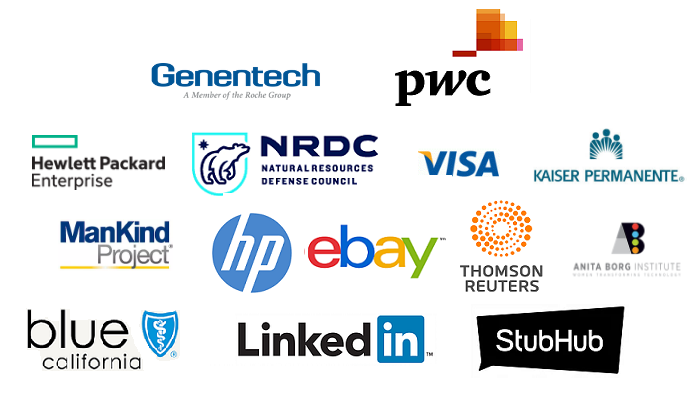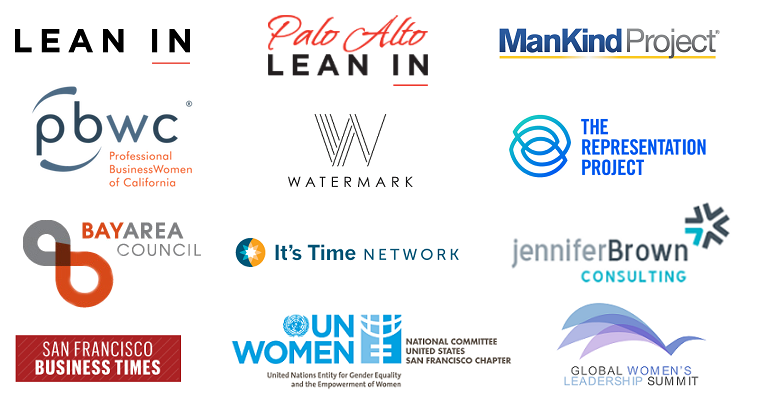
Create A Sense Of Belonging In Pt. 7 Of Problems, Opportunities And Solutions For Gender Equality In Corporate Culture
In Pt. 7 Of Problems, Opportunities And Solutions For Gender Equality In Corporate Culture which took place at the Better Man Conference 2017, we wrap up our panel discussion with corporate leaders entitled, The Inclusion Roadmap: Where to Start Engaging Men in the Workplace. While answering questions from the audience, the leaders articulate a common thread that suggests everyone has gifts to bring to the table and by creating a sense of belonging, creativity and innovation, a positive impact on the bottom line is likely.
The corporate panel includes Dr. Ronald Copeland from Kaiser Permanente, MD SVP and Chief Diversity Officer of National Diversity Inclusions, Strategy and Policy, Lesley Slaton Brown from HP Inc., Chief Diversity Officer, Nadia Chargualaf, Telstra VP of HR for U.S. Operations, Mike Dillon, Chief Diversity Officer at PwC and his hosted by Dale Thomas Vaughn, Co Founder of Inclusionary Leadership Group (formally known as Gender Leadership Group). I invite you to watch the video above or read the transcript below.
If you would like to read through or listen in on the full series, the first six parts of the series can be found here:
Part 1 Of Problem, Opportunities And Solutions For Gender Equality In Corp. Culture
Part 2 Of Problem, Opportunities And Solutions For Gender Equality In Corp. Culture
Part 3 Of Problem, Opportunities And Solutions For Gender Equality In Corp. Culture
Part 4 Of Problem, Opportunities And Solutions For Gender Equality In Corp. Culture
Part 5 Of Problem, Opportunities And Solutions For Gender Equality In Corp. Culture
Part 6 Of Problem, Opportunities And Solutions For Gender Equality In Corp. Culture
Audience Member #3:
Hey folks, it’s excellent to hear your expertise and experience, I really love it! I have a question. There’s a lot of conversation about diversity. One of the challenges I feel is challenging us as corporate America is we focus a lot on, as Florina said, “The ten key areas of diversity about gender, and race, and color, and religion.” and things like that but obviously diversity is much broader than that.
HOW DO WE MEASURE COGNITIVE DIVERSITY?
How do we measure cognitive diversity? Because that’s more than just numbers...that’s one question. The second question is about inclusion, how are you guys measuring inclusion? Because in some ways, it’s more important than just diversity.
Dr. Ronald Copeland:
We have generational diversity, and so as you heard in some of the earlier speakers’ comments, people of different generations emphasize the different aspects of diversity based on their lived experience. The boomers and the folks who lived through civil rights and those areas, those categories of diversity that were the basis for which many people and populations were discriminated against, are front and center in their minds because they lived through that on a personal basis and/or their parents did. So it’s personal and so that’s why it’s front and center and we get that. But as we are now into new generations that are living a different experience and connecting on a global basis routinely, they’re much more attuned to the issues of cognitive diversity, personality diversity, and so forth. Because when you’re spending a lot of time globally interacting with people, many of whom you only know in a virtual sense, those are the things that stand up and come up as ideas.

ALL OF IT HAS VALUE, IT'S ALL TOGETHER
I think the key is in inclusion from a cultural standpoint and a value-add standpoint is embracing all of that so that the people who are leading the D & I work have to really have a framework for diversity that is broader than just ethnic categories. The point I really want to make though is that it is an inclusion and those things as opposed to a binary approach, we're not talking about these things anymore, we're only going to talk about cognitive diversity, etc. All of it has value.
And when we talk about the value that diversity of experience, and thought and cognitive brains, much of that is shaped by people’s lived experiences and people’s lived experiences are significantly influenced by what they look like, how people react to what they look like, their gender, and so on. It’s all together.
I don't create false or artificial separations. I talk about embracing all of it and all of it can be added value if, again, we're coming from an inclusive orientation seeing value in difference or coming in fear and leveraging it to get complex problems solving done with the best ideas because everybody is looking at the problem from a different perspective and that’s an asset as opposed to a liability.
Dale Thomas Vaughn:
Go ahead.
Lesley Slaton Brown:
From the HP perspective we look at, and one is not heavily weighted than the other, we are about diverse perspectives. Diverse perspectives do come from gender and it does come from ethnic representation, it also comes from multi-nationalism.
We do business in a 170 countries across the globe so it’s important for us to be representative of the different religions and the different cultures that are represented at HP and again, in our customer base who we sell to and who we partner with. How we measure is we look at, and our whole diversity strategy is around what we call, the big strategy. It’s about belong, innovate, and grow.
CREATE A SENSE OF BELONGING, PEOPLE WILL INNOVATE BETTER, IMPACT THE BOTTOM LINE

If you get people in, you’ve got to first get the diversity, and then those diverse perspectives. You have to nurture an environment and a culture where people can thrive and truly feel like they are included and have a sense of belonging. Ultimately, those people are able to innovate better, they’re more creative and that impacts them as an individual and their growth and development, but also impacts the bottom line. How we measure that is we have what we call a ‘Voice in Action’ survey that we do annually and then we do pulse surveys on a regular basis around belonging.
One of the simple questions on that is, "Do you feel like you can be a part of and bring your ideas to the table? Do you feel like you have a place to belong within your organization?" We take that measurement very seriously. Not to mention the plethora of programs that we have that really help nurture inclusion and belonging within our workplace.
Dale Thomas Vaughn:
Maybe the last question there in the back.
Audience Member #4:
Hi, hello. I have a question and I guess it is in context. I work in tech so this is kind of a question that reflects on the interesting push back in the tech industry. I heard from one of you, I think from HP, when you were talking about your diversity targets it sounded a lot like quotas. One of the things that we hear a lot in the tech industry is that instituting quotas is a reverse discrimination and it lowers the bar. I think we have a guy at Google who wrote a paper and got fired because he actually stated that and questioned those policies. What do you say to your employees when they bring it up or they push back on diversity programs with those arguments?
Lesley Slaton Brown:
First of all, let me be very clear, when we set out, our mission was to develop the most diverse board of directors. It wasn't about putting targets or quotas in place, and if it were...oh well, we did it. And as a result of it, we've become very successful. But more importantly than that we do put out aspirational goals. We do business in, some might call them very obscure places and at times that may not warrant the attraction to some of the diverse targets that we're looking for or diverse perspectives that we might recruit to. Places like Corvallis, Oregon, and Boise, Idaho and others. So it is very important to us to have a balanced workplace.
IT IS NOT ALL ABOUT ETHNICITY, IT IS NOT ALL ABOUT GENDER, IT’S EVERYTHING
As far as push back goes, we have a very dedicated, very committed, and very passionate leadership team. Where we seem to get stuck is in that frozen middle that we often talk about. And so a lot of the work that we're doing is to really kind of unstick that middle or defrost them. In a way we do more programs around...because we see the direct benefit of the diversity that we have in our organization...it is not all about ethnicity, it is not all about gender....it’s everything, to be honest with you. As we look at diversifying our workplace, we look at honoring the different perspectives that we bring to the table and to be really transparent with you, I think that the culture has evolved to a place that if you’re not signed up to that, you’ll probably eventually self-select out of it.
Dale Thomas Vaughn:

I need to wrap this up and I just want to say a quick response to that because I feel that’s part of why we started the Gender Leadership Group (now Inclusionary Leadership Group), to just come in and talk to that frozen middle of people who look like me and try to help them and see the possibilities of being involved. I think Michael Kimmel does a really good job of saying, “The pie grows, it’s not one piece that you’re taking out. It’s the growing of the whole pie.”
THE PIE GROWS, IT’S NOT ONE PIECE THAT YOU’RE TAKING OUT - IT’S THE GROWING OF THE WHOLE PIE
Part of why we use the word "engaging" men is because that’s the goal. If we can see it as we're all on the same team to grow this pie together, getting men involved in that helps with the push back, it helps them see themselves as part of a team.
I want to thank you all for being part of this. There’s going to be more opportunity to have some questions in the lobby, etc. Thank you so much for all your expertise.
(audience applause)
- THE END -
Better Man Conference 2017 Recap Report

We are proud to share this recap report from the Better Man Conference 2017 as just last month, 200+ leaders and many great diverse speakers and panelists, both men and women came together to be a part of the movement to engage men as inclusionary leaders at the Better Man Conference 2017. This year we grew in both quantity and quality. That’s due to your involvement. We thank each and every attendee, speaker, sponsor, marketing partner, and supporter for being such an important part of the men's inclusionary leadership movement. See the recap report here.
THANK YOU to 2017 BETTER MAN CONFERENCE SPONSORS

THANK YOU to 2017 BETTER MAN CONFERENCE MARKETING PARTNERS


